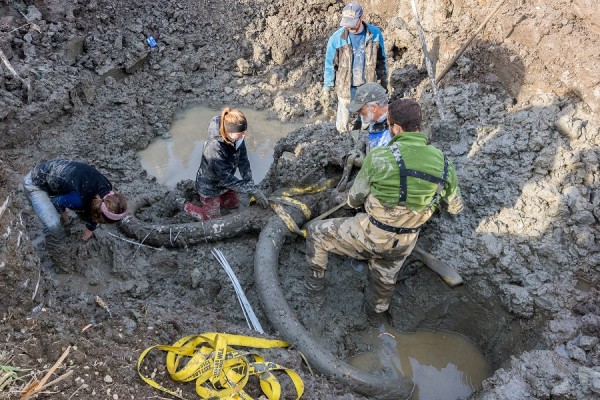By Ana Verayo, | February 28, 2017

Securing the mammoth skull and tusks with straps before hoisting it out of the pit. (Daryl Marshke, U_M Michigan Photography)
Scientists are now warning that bringing back to life extinct species can become more harmful as opposed to beneficial to modern day environments. Instead, scientists strongly suggest that the conservation and protection of threatened and endangered species today should be top priority.
In a recent study, a team from Harvard University led by George Church announced that they are just a few years away from creating a hybrid embryo of the extinct woolly mammoth that used to live during the Ice Age. However, a group of scientists counter this otherwise potentially unethical practice, since it can result in undesirable consequences of de-extinction.
Like Us on Facebook
In this new study, a team from the Carleton University in Canada estimated the risk and costs linked to bringing back extinct species to the modern world. They also focused on the negative impact this could have on ecosystems and biodomes.
According to author of the study, Joseph Bennett of Carleton University, the technical feasibility of de-extinction is within reach soon. Many species have become extinct due to human activity but bringing them back might not be an end to extinction.
Bennett explains that it is crucial to take a sober look at the potential benefits and drawbacks of de-extinction when it come to resources used. Since resources today are severely limited, it is better to place conservation efforts to protect current biodiversity.
Using data based on a certain number of endangered species native to New South Wales in Australia and New Zealand, scientists were able to analyze the costs and benefits of de-extinction. The team obtained this data from detailed databases maintained by local agencies and authorities to monitor their most threatened species. Also included are listing prescriptions and costs of actions required for protection and preservation of the species.
After collecting this data, the team identified some extinct species that were related to some threatened species in New South Wales and New Zealand that also lived in the same habitat before they disappeared. The team compared the living threatened species and the extinct species in order to estimate the conservation costs of bringing them back to life, including preserving and protecting them.
Bennett and his team concludes that reintroducing an extinct species to their old habitats may improve local existing biodiversity. However, when resources are consumed by these species rather than the current threatened species, more biodiversity is lost rather than gained.
Bennett says that if you are spending a lot on de-extinction, it is also a decision to not spend on the living species. De-extinction is a costly undertaking and many living species are now on the verge of extinction.
It may be better to spend money on the living rather than on species that have been long dead. This new study is published in the journal Nature Ecology and Evolution.
-
Use of Coronavirus Pandemic Drones Raises Privacy Concerns: Drones Spread Fear, Local Officials Say

-
Coronavirus Hampers The Delivery Of Lockheed Martin F-35 Stealth Fighters For 2020

-
Instagram Speeds Up Plans to Add Account Memorialization Feature Due to COVID-19 Deaths

-
NASA: Perseverance Plans to Bring 'Mars Rock' to Earth in 2031

-
600 Dead And 3,000 In The Hospital as Iranians Believed Drinking High-Concentrations of Alcohol Can Cure The Coronavirus

-
600 Dead And 3,000 In The Hospital as Iranians Believed Drinking High-Concentrations of Alcohol Can Cure The Coronavirus

-
COVID-19: Doctors, Nurses Use Virtual Reality to Learn New Skills in Treating Coronavirus Patients







